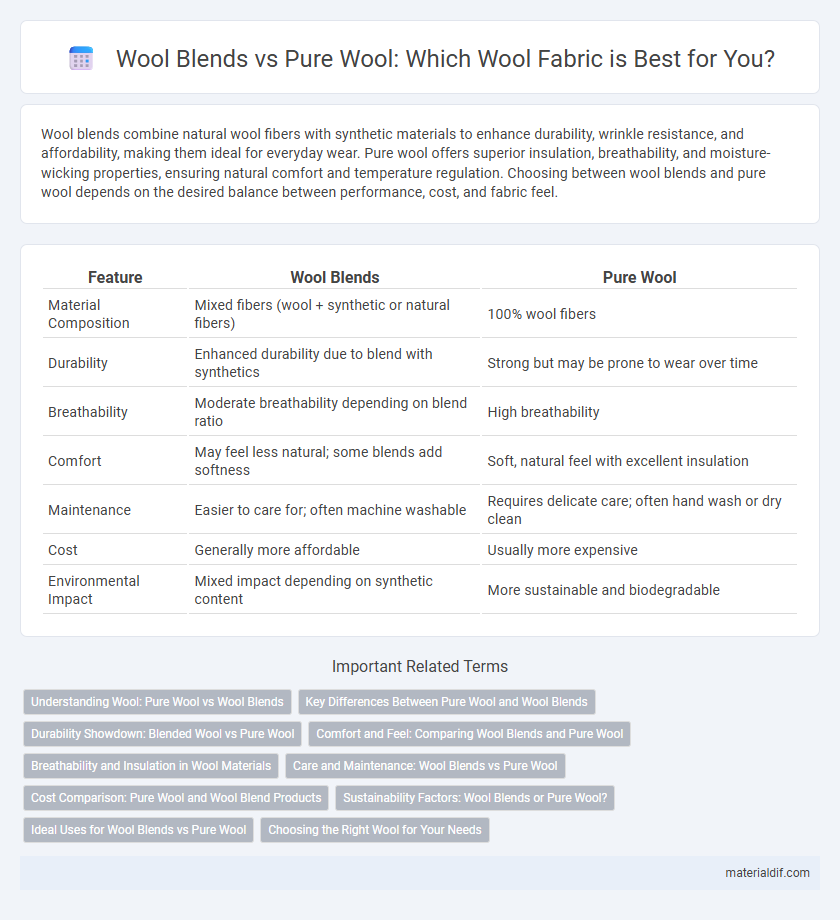Wool blends combine natural wool fibers with synthetic materials to enhance durability, wrinkle resistance, and affordability, making them ideal for everyday wear. Pure wool offers superior insulation, breathability, and moisture-wicking properties, ensuring natural comfort and temperature regulation. Choosing between wool blends and pure wool depends on the desired balance between performance, cost, and fabric feel.
Table of Comparison
| Feature | Wool Blends | Pure Wool |
|---|---|---|
| Material Composition | Mixed fibers (wool + synthetic or natural fibers) | 100% wool fibers |
| Durability | Enhanced durability due to blend with synthetics | Strong but may be prone to wear over time |
| Breathability | Moderate breathability depending on blend ratio | High breathability |
| Comfort | May feel less natural; some blends add softness | Soft, natural feel with excellent insulation |
| Maintenance | Easier to care for; often machine washable | Requires delicate care; often hand wash or dry clean |
| Cost | Generally more affordable | Usually more expensive |
| Environmental Impact | Mixed impact depending on synthetic content | More sustainable and biodegradable |
Understanding Wool: Pure Wool vs Wool Blends
Pure wool offers exceptional warmth, breathability, and natural moisture-wicking properties, making it ideal for insulation and comfort. Wool blends combine wool fibers with synthetic materials like polyester or nylon to enhance durability, stretch, and affordability while maintaining some natural fiber benefits. Understanding the balance between pure wool's luxury and wool blends' practicality helps consumers choose textiles suited to specific uses and budgets.
Key Differences Between Pure Wool and Wool Blends
Pure wool offers superior insulation, breathability, and natural moisture-wicking properties compared to wool blends, providing optimal comfort in varying climates. Wool blends combine wool with synthetic fibers like polyester or nylon, enhancing durability, wrinkle resistance, and cost-effectiveness, though often sacrificing some softness and thermal regulation. The choice between pure wool and wool blends depends on prioritizing natural fiber benefits versus performance enhancements and affordability.
Durability Showdown: Blended Wool vs Pure Wool
Blended wool fabrics combine natural wool fibers with synthetic materials, enhancing durability and resistance to abrasion compared to pure wool. Pure wool excels in breathability and natural insulation but can be more prone to pilling and wear over time. Choosing between blended wool and pure wool depends on the desired balance of longevity and natural fiber benefits for specific garment uses.
Comfort and Feel: Comparing Wool Blends and Pure Wool
Wool blends often combine natural wool fibers with synthetic materials like polyester or nylon, enhancing durability and wrinkle resistance while maintaining softness. Pure wool offers superior breathability and moisture-wicking properties, resulting in a cozy, warm feel that adapts to body temperature. Comfort in wool blends can be slightly less breathable, but they provide a smoother texture and greater stretch, appealing to those seeking a balance between softness and practicality.
Breathability and Insulation in Wool Materials
Wool blends often combine natural fibers with synthetic materials, enhancing durability while maintaining moderate breathability, though pure wool excels in moisture-wicking and air circulation, crucial for temperature regulation. Pure wool provides superior insulation due to its unique crimped fiber structure, trapping air effectively to retain warmth without overheating. Choosing between wool blends and pure wool depends on balancing breathability and insulation needs, with pure wool favored for natural climate adaptability.
Care and Maintenance: Wool Blends vs Pure Wool
Wool blends typically require less specialized care than pure wool, as the added fibers often increase durability and reduce shrinkage risk, enabling easier machine washing on gentle cycles. Pure wool demands more meticulous maintenance, including hand washing or dry cleaning, to preserve its natural elasticity, softness, and to prevent felting or shrinking. Proper storage with moth repellents is crucial for both, but pure wool garments benefit more from breathable bags to maintain fiber quality over time.
Cost Comparison: Pure Wool and Wool Blend Products
Pure wool products generally have a higher price point due to the cost of sourcing and processing natural fibers, reflecting superior insulation, breathability, and durability. Wool blends, combining wool with synthetic or other natural fibers, offer a more budget-friendly alternative while maintaining some benefits of wool such as warmth and moisture-wicking. Consumers typically choose wool blends for affordability and easier care, whereas pure wool remains preferred for premium quality and longevity despite the higher expense.
Sustainability Factors: Wool Blends or Pure Wool?
Pure wool offers superior biodegradability and natural renewable qualities, making it highly sustainable due to its biodegradation within months and minimal environmental impact during production. Wool blends, often combined with synthetic fibers like polyester, reduce overall biodegradability and increase microplastic pollution, compromising their sustainability despite enhanced durability and cost-effectiveness. Choosing pure wool supports eco-friendly fashion by prioritizing natural fiber lifecycle and reducing synthetic waste accumulation.
Ideal Uses for Wool Blends vs Pure Wool
Wool blends offer enhanced durability and wrinkle resistance, making them ideal for everyday wear, activewear, and casual garments that require easy maintenance. Pure wool excels in insulation and breathability, perfect for formal attire, winter coats, and high-performance cold-weather gear where natural fiber benefits are prioritized. Choosing between wool blends and pure wool depends on balancing comfort, longevity, and specific use cases such as formal wear versus casual or outdoor activities.
Choosing the Right Wool for Your Needs
Wool blends combine natural wool fibers with synthetic materials or other natural fibers, enhancing durability, stretch, and often reducing cost while maintaining some warmth and softness. Pure wool offers superior insulation, breathability, and moisture-wicking properties, making it ideal for cold-weather garments and sensitive skin. Choosing between wool blends and pure wool depends on factors like intended use, budget, and allergies, with blends suited for activewear and affordability, and pure wool preferred for luxury, warmth, and natural comfort.
Wool Blends vs Pure Wool Infographic

 materialdif.com
materialdif.com